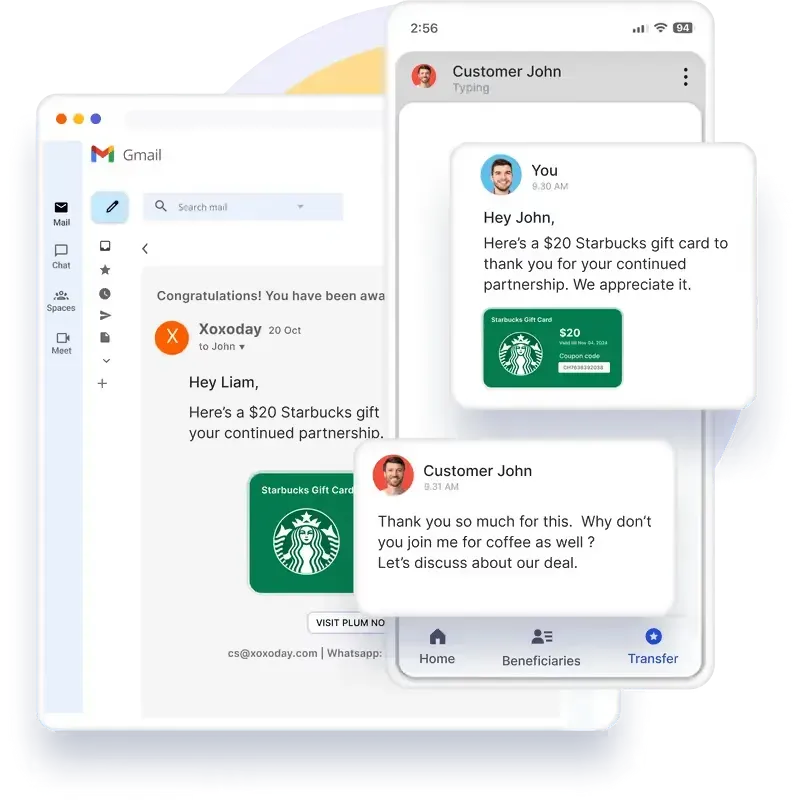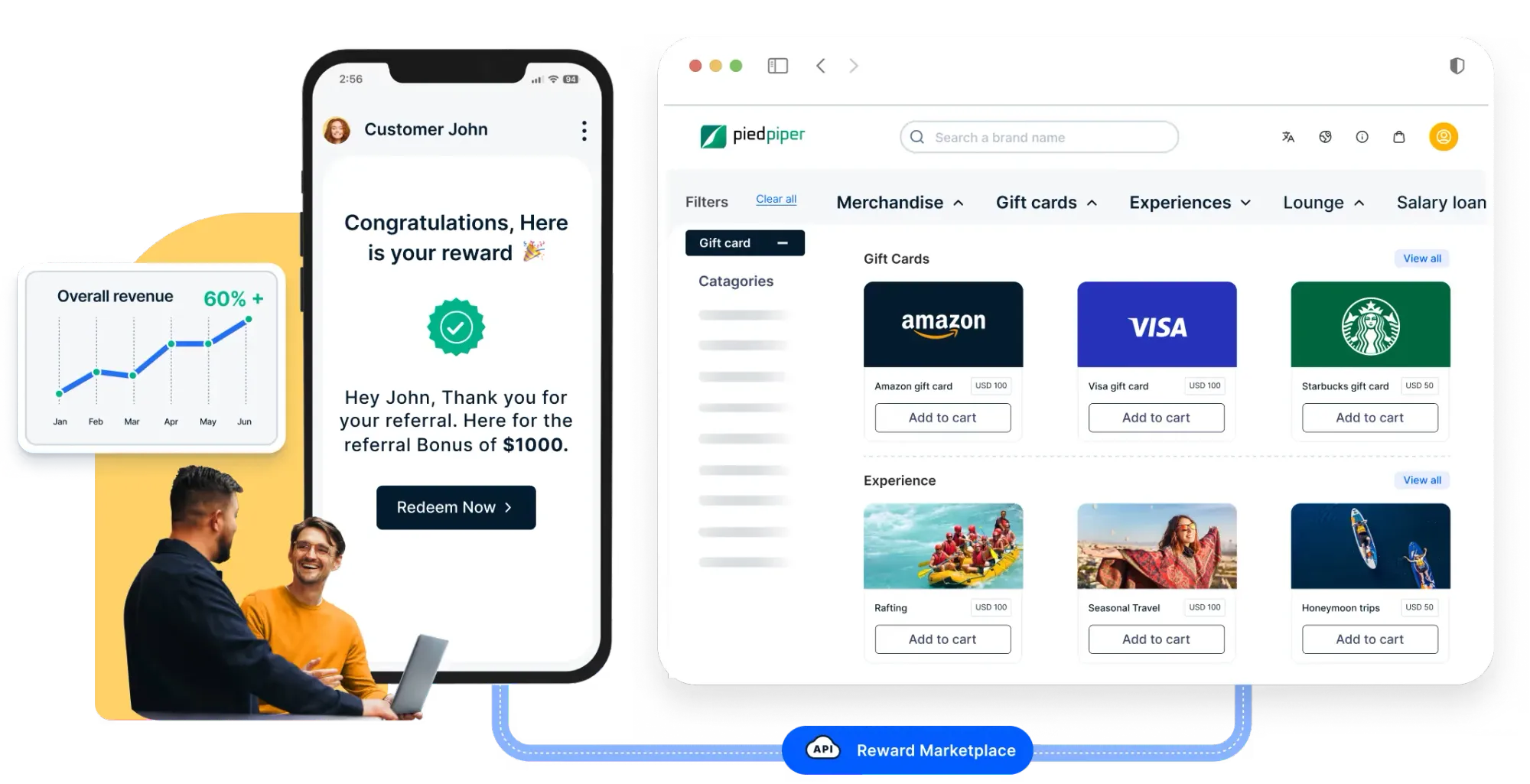Apa itu pemasaran hadiah dan bagaimana menggunakannya untuk akuisisi, loyalitas, dan retensi pelanggan
Pemasaran hadiah adalah salah satu cara paling efektif untuk melibatkan pelanggan Anda. Blog ini akan membahas lebih lanjut tentang cara menggunakan pemasaran hadiah dan bagaimana hal itu dapat membantu Anda.
Di halaman ini
- Apa yang dimaksud dengan pemasaran hadiah?
- Bagaimana program hadiah dapat membantu dalam pemasaran hadiah?
- Bagaimana pemasaran hadiah membantu Anda di seluruh saluran pemasaran?
- Jenis-jenis Program Pemasaran Hadiah
- Cara memilih hadiah yang tepat untuk pemasaran hadiah
- Kiat untuk membangun program hadiah pelanggan yang sukses
- Buka kekuatan pemasaran hadiah dengan plum
Program penghargaan dalam pemasaran berhasil dan kita tidak perlu melihat jauh-jauh untuk menemukan buktinya. Sebuahstudi baru-baru inimenemukan bahwa 82,4% pelanggan cenderung berbelanja lebih banyak dari toko yang memiliki beberapa bentuk program hadiah. Hal ini membuktikan keefektifan mengapa menggunakan pemasaran hadiah dan bagaimana hal tersebut dapat membantu Anda dalam mengungguli pesaing. Blog ini mencoba untuk menggali lebih dalam dan mencari tahu cara kerja dari strategi pemasaran yang dimaksud - Apa itu reward marketing dan bagaimana hal itu dapat membantu?
Apa yang dimaksud dengan pemasaran hadiah?
Pemasaran hadiah adalah penggunaan insentif secara strategis untuk mendorong tindakan berharga dari audiens target-baik pelanggan, afiliasi, pemberi pengaruh, atau karyawan. Tindakan ini dapat berkisar dari melakukan pembelian, berlangganan, dan mereferensikan teman hingga memberikan ulasan atau berbagi konten.
Idenya sederhana: tawarkan hadiah yang menarik untuk mendorong perilaku yang menguntungkan merek, sering kali lebih hemat biaya daripada metode pemasaran berbayar tradisional.
Bagaimana program hadiah dapat membantu dalam pemasaran hadiah?
Program penghargaan memiliki cakupan yang luas karena dapat digunakan untuk menciptakan keterlibatan yang lebih baik dengan - karyawan melalui penghargaan karyawan, mitra saluran, dan pelanggan melalui program penghargaan dan loyalitas yang berbeda (apa pun yang berkaitan dengan membangun hubungan antarmanusia).
Program hadiah bertindak sebagai mesin yang menggerakkan pemasaran hadiah dengan menciptakan cara yang terstruktur, dapat diulang, dan terukur untuk mendorong perilaku pelanggan. Alih-alih menawarkan diskon satu kali atau fasilitas acak, program hadiah memungkinkan merek untuk secara sistematis mendorong tindakan yang selaras dengan tujuan bisnis mereka-seperti mendaftar, melakukan pembelian berulang, atau mereferensikan teman.
Ketika diterapkan dalam pemasaran, hadiah dapat membantu Anda -
- Membangun koneksi
- Meningkatkan loyalitas pelanggan
- Memperdalam keterlibatan dan
- Menarik pelanggan baru

Pemasaran hadiah adalah praktik di mana Anda memanfaatkan program hadiah atau loyalitas melalui partisipasi program. Hal ini dilakukan dengan memberikan imbalan yang menarik dan atraktif.
Bagaimana pemasaran hadiah membantu Anda di seluruh saluran pemasaran?
Akuisisi:
Akuisisi pelanggan sangat penting untuk bisnis dari segala usia dan ukuran. Mampu menarik dan mengonversi pelanggan baru secara sistematis, membuat perusahaan tetap sehat dan berkembang - dan investor senang. Namun, bagaimana Anda melakukannya?
Pertimbangkan pemasaran hadiah. Pemasaran hadiah membantu Anda memberikan sesuatu yang lebih - baik itu insentif, kredit, hadiah fisik, imbalan uang atau bahkan imbalan non-moneter kepada pelanggan Anda. Hal terbaik tentang pemasaran hadiah adalah sifatnya yang multiguna. Pemasaran hadiah bukan hanya corong satu arah, tetapi juga roda gila yang membantu Anda mendapatkan jenis pelanggan yang tepat yang akan bertahan.
Retensi:
Membangun basis pelanggan baru itu mahal. Biayanya dapat bervariasi di seluruh industri. Namun menurut Mehdi Khosrow-Pour dalam bukunyabukunya"Emerging Trends and Challenges in Information Technology Management,"mengganti pelanggan lima kali lebih mahal daripada mempertahankan pelanggan lama.

Tren dan Tantangan yang Muncul dalam Teknologi Informasi
Pendekatan yang lebih baik adalah mempertahankan pelanggan yang Anda miliki, dengan memilih insentif pelanggan atau program pemasaran hadiah yang cerdas. Ini akan membantu Anda dalammempertahankan pelanggandan membuat mereka setia terhadap merek Anda. Mengetahui bahwa melakukan pembelian kedua dari merek Anda akan memberi pelanggan kode kupon / voucher akan membuat produk Anda lebih menarik daripada pesaing Anda.
Rujukan:
Manfaat lain dari pemasaran hadiah adalah dapat membantu Anda memberikan tip kepada calon pelanggan untuk melakukan pembelian - terutama jika didukung oleh rekomendasi teman.Hadiah rujukantersedia dalam berbagai bentuk dan ukuran, tetapi triknya adalah menawarkan hadiah yang melengkapi pengalaman merek Anda dan memenuhi kebutuhan pelanggan. Cara yang paling umum adalah -
- Memberi penghargaan kepada kedua belah pihak dengan kode kupon yang dapat ditukarkan pada pembelian berikutnya.
- Memberikan penghargaan kepada pemberi rekomendasi dengan poin bonus.
- Berkreasi dengan produk gratis.
Advokasi pelanggan:
Advokasi Pelanggan adalah cara yang memungkinkan merek untuk mendapatkan pelanggan baru dan berharga secara organik. Sikap positif pelanggan terhadap produk/layanan merek Anda dan membuat mereka merekomendasikan hal yang sama kepada orang lain setelah mengalaminya sendiri.
Andapendukung pelanggan Andadidorong oleh sesuatu yang disebut - SAPS (Status, Access, Power atau Stuff), dan pemasaran hadiah dapat melakukannya. Anda tahu, pemasaran hadiah bukan hanya tentang memberikan kupon dan barang gratis, tetapi juga menciptakan ekosistem di mana pelanggan dapat berbagi pengetahuan, keahlian, dan membuat pelanggan merasa bahwa pendapat mereka penting.
Jenis-jenis Program Pemasaran Hadiah
Pemasaran hadiah adalah strategi serbaguna yang meningkatkan keterlibatan, akuisisi, dan advokasi pelanggan. Baik digunakan untuk menarik pelanggan baru, memberi insentif kepada rujukan, atau memperkuat loyalitas merek, program hadiah dapat mendorong tindakan yang berarti dan menciptakan nilai jangka panjang. Berikut adalah beberapa jenis utama program pemasaran hadiah:
1. Program rujukan
Pemasaran rujukan mengubah pelanggan yang puas menjadi pendukung merek, mendorong mereka untuk membagikan merek Anda kepada teman, keluarga, dan kolega. Strategi dari mulut ke mulut ini memanfaatkan tautan rujukan, kode, dan gamifikasi untuk membuat berbagi menjadi mudah dan bermanfaat.

Peserta biasanya menerima insentif seperti diskon, kredit, atau hadiah uang tunai ketika referal mereka menyelesaikan tindakan yang diinginkan-seperti mendaftar, melakukan pembelian, atau meminta penawaran. Beberapa bisnis, seperti perusahaan asuransi, menyusun imbalan multi-tahap, menawarkan insentif awal untuk menghasilkan prospek dan insentif lainnya setelah konversi.
2. Kampanye akuisisi pelanggan berbasis hadiah
Merek semakin sering menggunakan insentif finansial untuk menarik pelanggan baru, seperti:
"Daftar hari ini dan dapatkan hadiah $50!" atau "Alihkan akun Anda dan dapatkan uang tunai $200!"
Kampanye-kampanye ini sering kali menawarkan uang tunai, kartu hadiahatau voucher yang menarik bagi konsumen tanpa mengurangi nilai produk yang dirasakan-tidak seperti strategi diskon tradisional. Bisnis dapat menggunakan promosi ini melalui iklan digital, kode QR, atau kampanye dengan waktu terbatas di berbagai saluran akuisisi pelanggan.
3. Pemasaran kemitraan
Selain referensi pelanggan, kemitraan dengan afiliasi, influencer, dan merek lain dapat menciptakan saluran pemasaran yang berdampak tinggi. Dengan memanfaatkan mitra tepercayabisnis dapat memperluas jangkauan mereka sambil mempertahankan kendali atas pesan merek dan insentif berbasis kinerja.
Mitra dapat menggunakan struktur hadiah yang serupa-diskon, hadiah eksklusif, atau cashback-untuk mendorong tindakan pelanggan, sehingga menjadikan pemasaran kemitraan sebagai metode yang efisien dan terukur untuk akuisisi pelanggan.
4. Program advokasi pelanggan
Mendorong pelanggan untuk memberikan memberikan ulasan, membagikan testimoniatau membuat konten tentang merek Anda akan meningkatkan kredibilitas dan kepercayaan. Mengingat lebih dari 70% konsumen memeriksa ulasan online sebelum membeli, program advokasi aktif dapat meningkatkan konversi secara signifikan.

Memberikan insentif kepada pelanggan dengan hadiah untuk meninggalkan ulasan asli, memposting gambar produk, atau berbagi pengalaman di media sosial dapat meningkatkan partisipasi. Namun, merek harus memastikan transparansi dan kepatuhan terhadap kebijakan ulasan untuk menjaga keasliannya.
5. Keterlibatan masyarakat dan insentif dukungan pelanggan
Beberapa merek memanfaatkan kekuatan komunitas mereka untuk memberikan dukungan dan keterlibatan pelanggan. GiffGaff, misalnya, memberikan penghargaan kepada pengguna yang membantu menjawab pertanyaan teknis dan mendukung pelanggan lain di forum.
Dengan membuat gamifikasi partisipasi masyarakat-menawarkan poinfasilitas eksklusif, atau keanggotaan premium-bisnis dapat mengubah pelanggan setia menjadi kontributor merek yang berharga, mendorong kolaborasi, dan mengurangi biaya operasional.

6. Program rujukan karyawan
Karyawan Anda dapat menjadi pendukung yang kuat untuk merek Anda. Program rujukan karyawan memberi penghargaan kepada anggota tim yang memperkenalkan produk atau layanan Anda ke jaringan pribadi mereka.
Misalnya, karyawan dapat menerima bonus atau tunjangan ketika referensi mereka berlangganan layanan atau melakukan pembelian. Hal ini tidak hanya mendorong penjualan, tetapi juga meningkatkan keterlibatan karyawan dengan memberi mereka kesempatan untuk berbagi penawaran berharga dengan teman dan keluarga mereka.
7. Program-program tunjangan dan pengakuan karyawan
Sama halnya dengan loyalitas pelanggan yang sangat penting, mempertahankan dan memotivasi karyawan sama pentingnya. Program penghargaan yang dirancang untuk karyawan dapat meningkatkan semangat kerja, kinerja, dan komitmen jangka panjang.
Perusahaan dapat menawarkan bonus uang, hari liburan ekstra, tunjangan yang dipersonalisasi, atau pengalaman eksklusif untuk mengakui kontribusi yang luar biasa. Berinvestasi dalam penghargaan karyawan akan menumbuhkan budaya penghargaan dan meningkatkan kepuasan di tempat kerja secara keseluruhan.
8. Sistem berbasis poin
Ini adalah semacam program hadiah yang memungkinkan pelanggan mengumpulkan poin yang dapat ditukarkan dengan berbagaiproduk/layanan. Program ini jauh lebih mudah disiapkan, sehingga menjadi jenis program retensi pelanggan yang paling populer.
Banyak bisnis e-commerce yang berjuang untuk mendapatkan pelanggan di pintu virtual mungkin menemukan solusi dalam program loyalitas semacam ini.program loyalitas.Ada berbagai cara pelanggan bisa mendapatkan poin tersebut. Misalnya - berbagi di media sosial, kompensasi keluhan, email, atau tindakan lain yang Anda lakukan untuk mengarahkan lalu lintas ke situs Anda.
9. Program pembeli yang sering
Ini adalah alat yang sangat baik untuk mempertahankan loyalitas merek. Biasanya dalam bentuk kartu hadiah, voucher, diskon, gratis, atau perlakuan khusus untuk pelanggan. Biasanya diberikan kepada pelanggan yang datang ke situs atau toko Anda dan lebih sering menekan tombol "beli".
Ini adalah program retensi pelanggan yang mudah dan umum digunakan untuk bisnis teknis (Amazon, Victoria Secrets) dan non-teknis (kedai kopi, pom bensin).
10. Gamifikasi
Gamifikasi bukanlah taktik baru di bidang pemasaran. Perusahaan telah menciptakan pengalaman bermain game dalam lingkungan non-game untuk meningkatkan penjualan. Gamifikasi akan selalu relevan karena memainkan naluri kompetitif alami manusia, untuk memicu tindakan dan memengaruhi pilihan pembeli.
Jenis program ini dapat digunakan untuk akuisisi dan retensi pelanggan. Ada beberapa elemen yang berbeda dalam gamifikasi, dan masing-masing memberikan hasil yang berbeda -
- Poin reward yang dapat ditukarkanmemberikan umpan balik yang memenuhi kebutuhan pelanggan akan kepuasan instan.
- Lencanaseperti simbol status visual. Lencana memengaruhi perilaku yang memicu pelanggan untuk lebih terlibat dengan merek Anda, untuk mendapatkan lebih banyak lencana.
- Pencapaianmengungkapkan perjalanan sukses pelanggan dengan merek Anda. Tonggak ini menginspirasi rasa pencapaian dan lebih banyak kompetisi.
- Avatardapat digunakan untuk menciptakan konteks naratif. Avatar memungkinkan pelanggan untuk menjadi bagian dari komunitas, yang memicu lebih banyak minat.
11. Kontes / Undian
Kontes/undian dirancang untuk memenuhi kebutuhan manusia untuk menang. Kemenangan tidak ada gunanya jika tidak ada hadiah. Namun, cara menentukan kemenangan berbeda untuk kontes dan undian. Dalam undian, pemenang dipilih berdasarkan keberuntungan.
Hadiahnya bisa berupa apa saja, mulai dari stiker, kaos, rumah, mobil, hingga uang tunai yang sangat besar. Ini adalah cara yang bagus untuk mendapatkan pelanggan baru. Kontes, di sisi lain, menarik pemenang berdasarkan prestasi. Dalam kasus seperti itu, hadiah juga merupakan sesuatu yang menarik minat dan memotivasi pelanggan untuk mengikuti kontes. Ini adalah alat yang berguna untuk mempertahankan pelanggan yang sudah menjadi bagian dari basis target Anda. Kontes dan undian bersama adalah kekuatan yang harus diperhitungkan. Mereka tidak hanya menarik minat tetapi juga membantu memperluas jangkauan Anda ke target audiens yang lebih besar.
12. Ulasan produk
Sektor e-commerce biasanya menggunakan pemasaran hadiah semacam ini. Pelanggan dapat menilai dan mengomentari produk yang telah mereka beli di halaman produk. Konsumen lain dapat membaca komentar saat membuat keputusan pembelian. Namun, mendorong pelanggan untuk membagikan umpan balik positif mereka tidaklah mudah.
Apa untungnya bagi mereka?
Ini adalah situasi yang saling menguntungkan karena -
- Hal ini akan meningkatkan lalu lintas, karena pelanggan akan kembali untuk menukarkan poin mereka.
- Peringkat dan ulasan mereka membantu pelanggan baru dalam membuat keputusan penting untuk membeli.
Cara memilih hadiah yang tepat untuk pemasaran hadiah
Memilih hadiah yang tepat sangat penting untuk memastikan keberhasilan inisiatif pemasaran hadiah apa pun. Baik Anda berfokus untuk mendapatkan pelanggan baru, mendorong loyalitas, atau meningkatkan retensi, strategi hadiah Anda harus selaras dengan preferensi audiens, tindakan yang diinginkan, dan identitas merek Anda.
Berikut ini adalah kerangka kerja yang komprehensif untuk membantu Anda membuat pilihan yang tepat:
1. Tentukan tujuan kampanye hadiah
Mulailah dengan mengidentifikasi tindakan apa yang Anda ingin audiens Anda lakukan. Jenis hadiah yang Anda tawarkan harus secara langsung selaras dengan tujuan pemasaran Anda.
- Untuk akuisisi pelanggan: Pilih hadiah yang menarik minat langsung dan mendorong konversi pertama kali. Misalnya, kartu hadiah elektronik Starbucks senilai $10 untuk pengguna baru yang menyelesaikan pendaftaran atau mengunduh aplikasi Anda.
- Untuk retensi: Fokus pada insentif yang membangun kebiasaan dan mendorong penggunaan berulang. Pikirkan tentang kredit langganan sebesar $25 setelah pesanan bulanan ketiga.
- Untuk loyalitas: Tawarkan fasilitas bernilai tinggi dan berbasis status yang memperdalam afinitas merek, seperti akses ke pengalaman premium atau akses awal eksklusif untuk mendapatkan produk.
2. Pahami audiens Anda
Pilihlah hadiah yang mencerminkan gaya hidup, nilai, dan perilaku audiens Anda. Salah satu kesalahan terbesar dalam pemasaran hadiah adalah mengasumsikan bahwa semua pelanggan termotivasi oleh hal yang sama.
- Untuk kaum milenial perkotaan atau Gen Z: Hadiah digital populer seperti Netflix, Uber Eats, atau kartu hadiah DoorDash menarik bagi gaya hidup mereka yang mengutamakan kenyamanan.
- Untuk para profesional: Hadiah kesehatan dan produktivitas seperti langganan Headspace, kredit Audible, atau kartu hadiah Apple bekerja dengan baik.
- Untuk konsumen yang memiliki kesadaran sosial: Izinkan mereka untuk mengubah poin menjadi donasi amal (misalnya, melalui platform seperti DonorsChoose atau Feeding America).
Lakukan survei, analisis persona pembeli, atau manfaatkan data demografis untuk memahami apa yang memotivasi audiens target Anda.
3. Sesuaikan nilai hadiah dengan tindakan yang diambil
Nilai hadiah harus sebanding dengan upaya atau komitmen pengguna. Jika tindakan tersebut membutuhkan lebih banyak waktu atau uang dari pelanggan, maka hadiah harus mencerminkan hal tersebut.
- Tindakan yang tidak membutuhkan banyak usaha (misalnya, pendaftaran melalui email): Tawarkan hadiah mikro berbiaya rendah namun bermakna, seperti kartu hadiah elektronik Dunkin' senilai $5.
- Tindakan dengan upaya tinggi (misalnya, berlangganan atau membeli): Gunakan insentif bernilai lebih tinggi seperti kartu hadiah Best Buy senilai $50 atau bundel barang bermerek.
Pendekatan ini memastikan hadiah terasa sesuai dan bermanfaat, sehingga meningkatkan kemungkinan konversi.
4. Menawarkan personalisasi dan pilihan
Membiarkan pelanggan memilih hadiah mereka akan meningkatkan kepuasan dan keterlibatan. Pendekatan satu ukuran untuk semua jarang berhasil, terutama dengan basis pelanggan yang beragam.
- Menyediakan akses ke katalog hadiah digital dengan pilihan yang luas-ritel (Target, Walmart), bersantap (Chipotle, Grubhub), perjalanan (Delta Airlines, Airbnb), atau kesehatan (ClassPass, Calm).
- Gunakan segmentasi untuk menyesuaikan hadiah dengan persona pelanggan yang berbeda-ibu baru, orang yang sering bepergian, penggemar teknologi, dan banyak lagi.
Hadiah yang dipersonalisasi membuat merek Anda terasa lebih manusiawi dan meningkatkan hubungan emosional.
5. Memastikan kemudahan pengiriman dan penukaran
Hadiah terbaik adalah hadiah yang dapat diakses secara instan, mudah digunakan, dan tidak perlu melewati berbagai rintangan. Proses penukaran yang rumit dapat menghilangkan antusiasme pelanggan dan mengurangi hasil kampanye.
- Pilihlah hadiah digital daripada hadiah fisik untuk menghilangkan penundaan dan kerepotan pengiriman.
- Gunakan kartu hadiah berbasis tautan atau yang dikirimkan melalui email dari platform seperti Xoxoday Plum untuk memastikan pemberian hadiah secara real-time.
Sebagai contoh, merek-merek seperti Dropbox dan Instacart menggunakan hadiah instan untuk rujukan, menjaga prosesnya tetap lancar dan memuaskan.
6. Menyelaraskan hadiah dengan identitas merek Anda
Hadiah Anda adalah titik sentuh merek. Hadiah tersebut harus memperkuat kepribadian, nada, dan janji merek Anda. Hadiah yang terasa tidak selaras dengan merek Anda dapat membingungkan atau mengasingkan audiens Anda.
- Jika Anda adalah merek gaya hidup mewah: Tawarkan pengalaman premium seperti paket spa, barang dagangan eksklusif, atau pengalaman bersantap mewah.
- Jika Anda adalah merek yang mengedepankan teknologi: Tawarkan hadiah yang ramah gadget seperti perangkat Amazon Echo atau aksesori Logitech.
- Jika keberlanjutan adalah inti dari merek Anda: Sertakan kredit penyeimbangan karbon atau donasi kepada organisasi lingkungan seperti The Nature Conservancy.
Kuncinya adalah menggunakan hadiah Anda untuk memperkuat narasi yang sudah disampaikan oleh merek Anda.
Kiat untuk membangun program hadiah pelanggan yang sukses
Program hadiah yang berjalan dengan sempurna haruslah bermanfaat, menarik, dan memotivasi. Berikut adalah beberapa tips yang perlu dipertimbangkan saat menjalankan program pemasaran hadiah:
- Buatlah hadiah yang menarik:Pelanggandapat mendaftar ke program hadiah Anda, namun hal ini tidak selalu berarti loyalitas. Tahukah Anda? Hanya13%pelanggan yang benar-benar loyal. Oleh karena itu, program hadiah Anda harus menarik dan cukup menarik bagi pelanggan untuk mendaftar dan menggunakannya secara teratur. Sebagai contoh, banyak salon kecantikan kelas atas yang membebankan biaya kepada anggotanya untuk bergabung, tetapi juga menawarkan kupon musiman dan bulanan dengan jumlah yang sama untuk mengimbangi biaya program.
- Buatlah program hadiah yang mudah dimengerti:Salah satu bagian yang paling rumit dalam meluncurkan program hadiah pelanggan adalah menjelaskannya kepada pelanggan. Jika rencana Anda terlalu membingungkan, atau memakan waktu, pelanggan Anda tidak akan mendaftar. Di sini, minimalis adalah kuncinya. Saat menjelaskan program Anda, jaga agar bahasanya tetap sederhana dan deskripsinya tidak terlalu panjang (satu atau dua kalimat), dan jangan lupa untuk menyebutkan apa manfaatnya bagi mereka.
- Penghargaan harus relevan:Imbalanmenciptakan loyalitas hanya jika perusahaan Anda tahu bagaimana cara berbagi nilai. Artinya, Anda harus memberikan reward yang relevan dan berharga bagi pelanggan. Cara terbaik untuk melakukannya adalah dengan membuat tingkatan yang berbeda. Segmentasikan pelanggan Anda berdasarkan tempat, waktu, dan cara mereka berbelanja, lalu berikan reward yang sesuai.
Buka kekuatan pemasaran hadiah dengan plum
Pemasaran hadiah bukan hanya sebuah taktik-ini adalah pengubah permainan untuk akuisisi, retensi, dan advokasi pelanggan. Dengan menerapkan program rujukan, insentif loyalitas, dan pengalaman gamified, bisnis dapat menciptakan keterlibatan yang berarti yang mengubah pembeli biasa menjadi pelanggan seumur hidup.
Namun, mengelola program reward dalam skala besar membutuhkan infrastruktur yang tepat. Plum menyederhanakan prosesnya dengan menawarkan:
- Katalog hadiah global yang luas - Kartu hadiah digital, pengalamancashback, dan banyak lagi.
- Distribusi hadiah otomatis - Atur pemicu untuk pengiriman instan dan tanpa hambatan.
- Opsi penukaran yang fleksibel - Biarkan pelanggan memilih hadiah yang sesuai dengan mereka.
- Integrasi tanpa hambatan - Terhubung dengan mudah dengan CRM, e-commerce, atau platform loyalitas Anda.
Jadikan strategi pemasaran hadiah Anda mudah dan berdampak. Tingkatkan konversi, pertahankan pelanggan, dan ciptakan loyalitas merek yang langgeng dengan Plum.
Siap untuk meningkatkan permainan pemasaran hadiah Anda? Pesan demo dengan Plum hari ini!


















